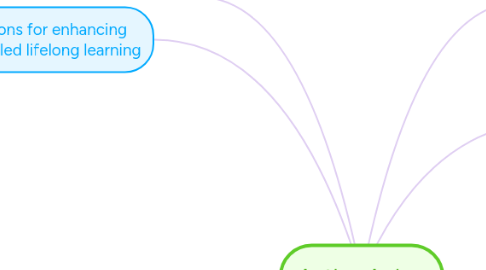
1. ICT support learning
1.1. positive effect of ICT
1.1.1. provide new ways to support informal learning
1.1.1.1. being social and interacting with other people (e.g., through social computing)
1.1.1.2. participate and create communities
1.1.1.3. collaborative online resources
1.1.1.4. individualized learning
1.1.1.5. compensate for disabilities
1.1.2. provide new ways to support organized education
1.1.2.1. improve knowledge and capabilities for practical tasks
1.1.3. ICT tools are flexible in supporting learning
1.1.3.1. used in place people gather for learning
1.1.3.2. used in a common place for social communication
1.2. potential challenge of ICT
1.2.1. tools
1.2.1.1. current ICT tools often not user-friendly for older people (lack of convenient access)
1.2.2. methods
1.2.2.1. older people do not often use ICT tools (lack of skills)
1.2.3. resources
1.2.3.1. contents are not relevant for older people
1.3. agenda for further research
1.3.1. ICT tools should meet the need of older people
1.3.1.1. interface friendly
1.3.1.2. easy to use
1.3.1.3. content should be revenant to older people's learning request
1.3.2. Develop ICT-enabled learning opportunities
1.3.2.1. support the development of informal learning opportunities (e.g., communities, local meeting places, and ICT platforms)
1.3.2.2. promote intergenerational learning
1.3.2.2.1. provide the opportunity for others to learn from them
2. Suggestions for enhancing ICT-enabled lifelong learning
2.1. Supporting local communities
2.2. Encouraging ICT-based networking for communities
2.3. Promoting ICT-related learning opportunities and their benefits
2.4. Developing the content of ICT literacy courses
2.5. Funding R&D projects
2.6. Holistic policies
3. Learning and Ageing
3.1. learning needs and motivations of differentiation (older people)
3.1.1. relate to personal well-being
3.1.1.1. health
3.1.1.2. wealth
3.1.1.3. social relation
3.1.2. improve knowledge/abilities to do practical tasks
3.1.2.1. new situations
3.1.2.2. new tools
3.1.3. an important activity in itself
3.1.3.1. improving personal fulfilment
3.1.3.2. social connections
3.1.3.2.1. stay active
3.1.3.2.2. avoid being left behind
3.2. barriers for older people
3.2.1. physical limitations
3.2.2. ageing cognitive abilities
3.2.3. existing learning capabilities
3.2.3.1. gender and previous education
3.2.3.2. lack of belief in one's own capabilities
3.2.4. lack of motivation
3.2.5. financial issue
3.2.6. age diversity in one learning environment
3.2.6.1. comfortable environment for both old and young
3.2.6.2. intergenerational learning groups
3.2.6.2.1. provide the opportunity for others to learn from older people
4. Lifelong and lifewide learning
4.1. development of role and organization of learning in the future
4.1.1. different people
4.1.2. social networks
4.1.3. organizations
4.1.4. educational institutions
4.1.5. workplaces
4.2. change of learning tools and approaches
4.2.1. meet the different needs of older people.
4.3. participation of older people
4.3.1. provide suggestions for development processes of tools

